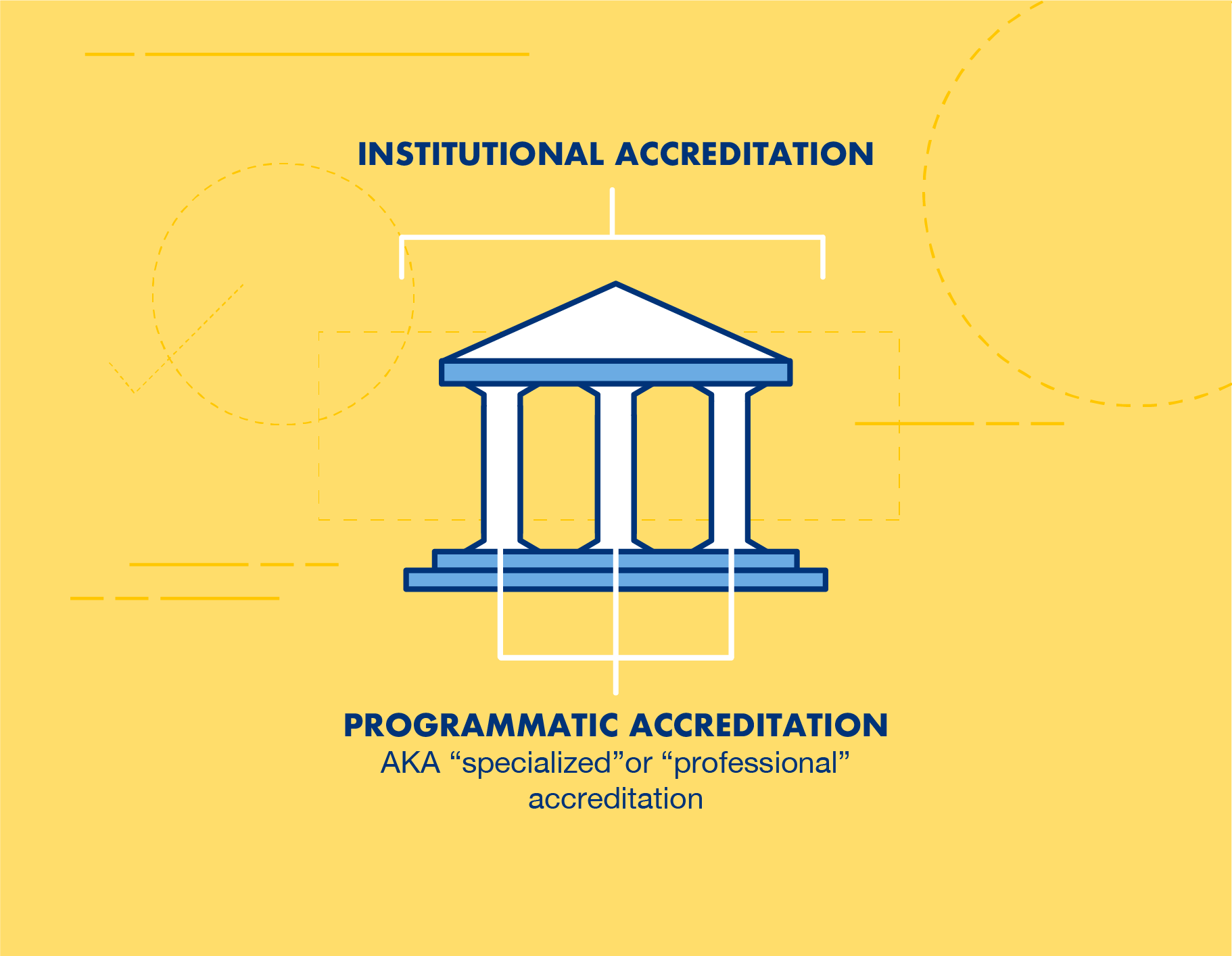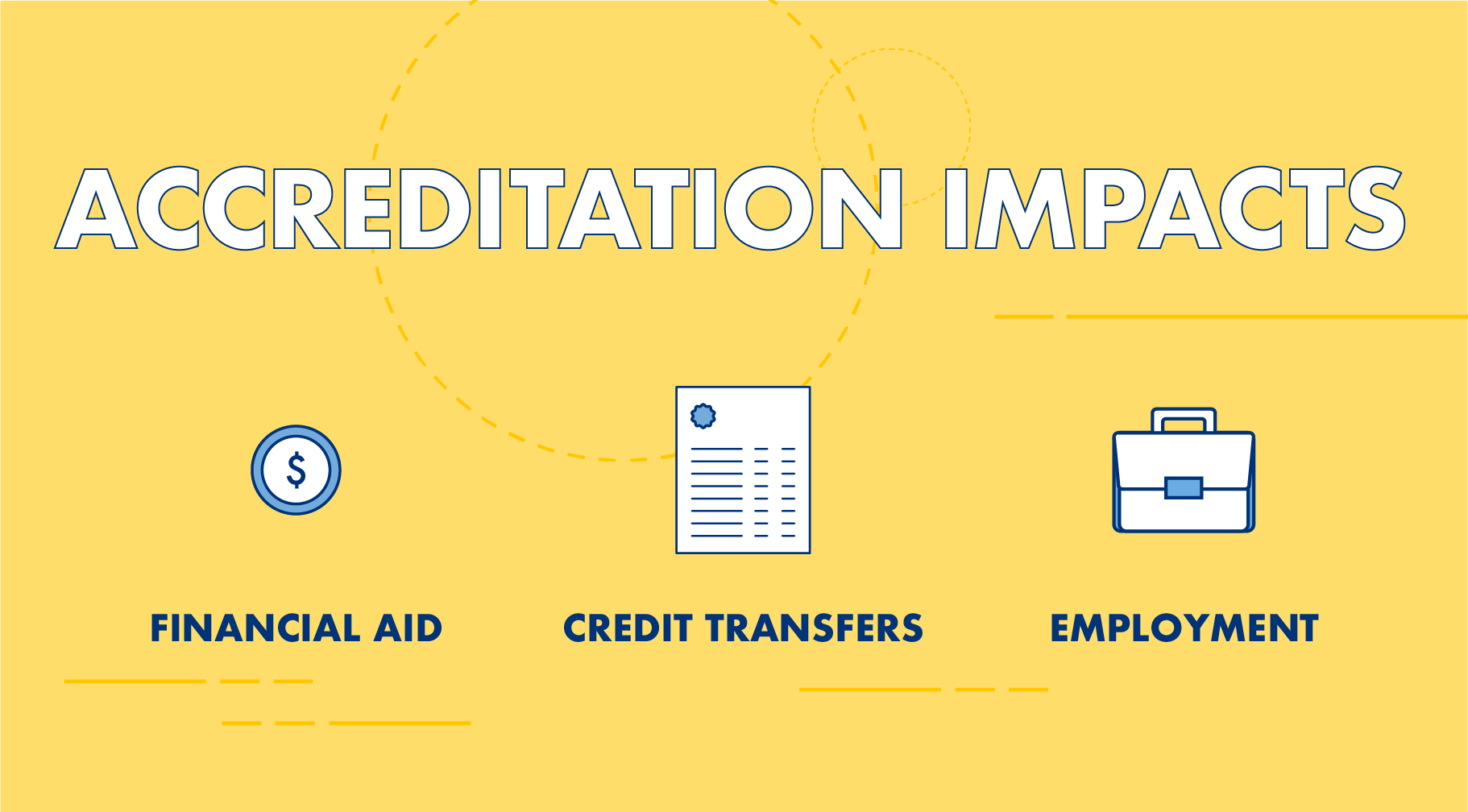One of the most important factors to consider when selecting a college or university is whether or not your institution of choice is accredited nationally or regionally at the institutional level. The type of accreditation plays a role in areas that may impact you as both a student (such as cost or how many credits may transfer if you switch schools) and after graduation (such as employability, tuition reimbursement, and employer background checks).
Learn more about differences between national and regional institutional accreditation, why it’s important that your institution is accredited, and tips to help verify your college or university’s accreditation status.
How Are Colleges Accredited?

Educational institutions are either regionally or nationally accredited. Accreditation is a voluntary process that ensures a college, university, or degree program meets a universal standard for quality. This gives an institution and its graduates credibility with other institutions and employers. Institutional accreditation is different from programmatic accreditation – which is covered below.
Contrary to popular belief, the U.S. Department of Education (USDOE) does not accredit educational institutions and/or programs. However, the USDOE and the non-profit Council for Higher Education Accreditation (CHEA) oversee the accreditation process. They review the federally-recognized agencies that set accreditation standards.
Whether or not an institution offers degree programs online, on campus, or both, is irrelevant when it comes to accreditation. They answer to the same governing organizations that ensure students receive a quality education.

What Is National Institutional Accreditation?
National accreditation agencies focus on accrediting trade and vocational schools, as well as career programs that offer certifications and degrees.
There are several recognized national accreditation agencies, including:
- Distance Education & Training Council (DETC)
- Accrediting Commission of Career Schools and Colleges (ACCSC)
- Council on Occupational Education (COE)
- Transnational Association of Christian Colleges and Schools, Accreditation Commission (TRACS)
- Accrediting Council for Continuing Education and Training (ACCET)
- Association for Biblical Higher Education (ABHE)
- Association of Advanced Rabbinical and Talmudic Schools (AARTS)
- Council on Occupational Education (COE)
- Distance Education Accrediting Commission (DEAC)
- National Accrediting Commission of Career Arts and Sciences (NACCS)
- Accrediting Council for Independent Colleges and Schools (ACICS)*
*In 2016, ACICS lost its recognition as an accrediting agency. In April 2018, the USDOE temporarily reinstated its recognition while it conducts further review of ACICS.
What Is Regional Institutional Accreditation?
Regional accreditation agencies oversee institutions that place a focus on academics that are state-owned or non-profit colleges or universities. There are six regional accrediting agencies for higher education institutions in the U.S. These agencies oversee institutions within their particular clusters of states.

The six agencies are:
- Middle States Commission on Higher Education (MSCHE)
- NY, NJ, PA, DE, MD, Washington D.C.
- New England Association of Schools and Colleges (NEASC)
- Northwest Commission on Colleges and Universities (NWCCU)
- AK, ID, MT, NV, OR, UT, WA
- Higher Learning Commission (HLC)
- AR, AZ, CO, IO, IL, IN, KS, MI, MN, MO, ND, NE, OH, OK, NM, SD, WI, WV, WY
- Southern Association of Colleges and Schools (SACS)
- FL, GA, KY, LA, MS, NC, SC, AL, TN, TX, VA
- U.S. students in Mexico, the Caribbean, Central America, and South America
- Western Association of Schools and Colleges (WASC)
- CA, HI
- The Hawaiian territories of Guam, American Samoa, Northern Marianas Islands, the Federated States of Micronesia, Palau, the Pacific Rim, East Asia, and parts of the Pacific and East Asia
What Is the Difference Between National and Regional Institutional Accreditation?
There are a few other ways that regionally accredited and nationally accredited institutions differ:

Regionally-Accredited Institution
Nationally-Accredited Institution
Considered the most prestigious and widely-recognized type of accreditation, regionally-accredited schools are reviewed by their designated regional agency.
Nationally-accredited agencies review institutions of a similar type, such as career, vocational, and technical (art & design, nursing, etc.) schools.
May be more expensive than nationally-accredited schools.
May be less expensive than regionally-accredited schools.
More selective during the admissions process.
Has more relaxed admission standards.
Mostly academic, non-profit institutions (must fundraise in order to meet their budget via private donations, federal grants, and legacy giving).
Predominantly for-profit institutions (earn revenue via enrollment or selling educational products). They may also have shareholders they must answer to.
Typically, regionally-accredited schools do not accept credits from nationally-accredited schools.
Credits are easily transferred to other regionally-accredited schools.
Typically, nationally-accredited schools will accept credits from both regionally- and nationally-accredited schools.
Credits are not transferable to a regionally-accredited college.
Eligible for all corporate tuition reimbursement plans.
Employers do accept nationally accredited degrees, but graduates are not always eligible for corporate tuition reimbursement plans.
What Is Programmatic Accreditation?
There is a third type of accreditation that prospective students should look for when evaluating institutions: programmatic accreditation—sometimes called “specialized accreditation” or “professional accreditation.”
While national and regional accrediting agencies review higher educational institutions as a whole, programmatic accrediting agencies examine individual academic units, programs or disciplinary offerings to ensure they are providing students with a quality education in a particular area of study. Programmatic accreditation is often at the national level since these agencies cover a particular specialty and evaluate all programs nationally within that specialty, such as schools of business, or nursing programs. This type of national programmatic accreditation differs from the national institutional accreditation covered above.

Drexel University is regionally accredited by the Middle States Commission on Higher Education (MSCHE). Many programs available at Drexel also hold national programmatic accreditation, including:
- The nursing programs at Drexel University are accredited by the Commission on Collegiate Nursing Education (CCNE)
- Drexel’s LeBow College of Business is accredited by the Association to Advance Collegiate Schools of Business (AACSB)—a distinction awarded to fewer than 5% of business schools worldwide
- Drexel University’s online accredited Master of Science in Library and Information Science (MSLIS) program is fully accredited by the American Library Association (ALA) and is ranked among the top 10 library science programs in the country
Why Is It Important For My School to Be Accredited?
If you attend an institution that is not nationally or regionally accredited, it can be a waste of time and money. Making sure your school is accredited is important for a number of reasons that can affect you both now and later, including:
- Financial Aid
Students cannot receive federal financial aid if they attend an institution that is not regionally or nationally accredited. In order to receive federal financial aid, an institution must be a Title IV-eligible institution. Title IV refers to the section of the Higher Education Act that oversees federal student aid. Institutions deemed Title IV-eligible are qualified by the U.S. Department of Education. Students that attend them are eligible to receive federal student financial aid. Title IV-eligible institutions can be either regionally or nationally accredited.
- Credits will not Transfer
In the event you decide to transfer, your new institution may not accept credits from a non-accredited institution.
- Impact on Employment
Over 50% of all employers conduct background checks and confirm the educational credentials of potential employees. Graduating from an accredited institution lets employers know you’ve received your degree from a legitimate institution that has given you the skills needed to succeed in your chosen field.

Transferring Between Regionally and Nationally-Accredited Schools
Over 27.2% of students—roughly 1 in 4—transfer to institutions outside of the state where they began their college journey. Some transfer while they’re still an undergraduate. Others decide to pursue a master’s or doctoral degree at a different institution from where they earned their associates or bachelor’s degree.
If you’re currently attending a regionally-accredited institution and planning to transfer, credits are easily transferred to other regionally-accredited institutions, even if your new institution is accredited by a different accrediting body than the one where you are currently enrolled. However, credits are often reviewed on a course-by-course basis or by a specific academic department to determine which credits will transfer.

Will I Lose Credits If I Transfer?
If you’re transferring institutions, it’s possible that you may not lose any credits. However, two-thirds of students do. No matter the accreditation of your former institution, it’s important to speak to a college’s transfer credit evaluator to know where you stand and how many of your credits will transfer. Students transferring for the first time lost an average of 13 semester credit hours — nearly 1/10th of the total amount of semester credits (120) required to graduate with a bachelor’s degree. That’s the equivalent of having to complete an additional semester in order to graduate.
How Does Transferring Affect Financial Aid?
As long as the institution they are attending is accredited, students are eligible to apply for federal financial aid. If an institution is not accredited, a student cannot receive federal financial aid. Switching from a nationally accredited to a regionally accredited institution (or vice versa) has no effect on the amount of federal grants or loans a student may receive.
Institution-based financial aid (such as scholarships) are awarded at the discretion of each college or university and depends on the individual’s need or eligibility.
Making Sure Your Institution Is Properly Accredited
Making sure your institution is properly accredited is key to getting the most from your education. Here are some warning signs and actionable tips for ensuring the institution to which you apply, has either national or regional institutional accreditation.

Here’s how you can be sure that your institution is accredited:
- Check for national or regional institutional accreditation
Look at the Department of Education’s Database of Accredited Postsecondary Institutions and Programs (DAPIP) to be sure your institution is listed as either nationally or regionally-accredited.
- Find out if your intended career path requires programmatic accreditation:
If you’re pursuing a career in teaching, business, nursing, or a specialized area, it may benefit you to verify if your institution's degree program is accredited. Consult the CHEA database by either institution and/or program to confirm it’s nationally or regionally-accredited, as well as if it has related programmatic accreditations.
Bringing It All Together
Now that you know more about the difference between regionally-accredited and nationally-accredited institutions, continue along the path to ignite your future. Drexel University, regionally accredited by the Middle States Commission on Higher Education, has over 150 online degree and certificate programs — with some that also hold programmatic accreditation, offers students an opportunity to learn from the best, and with the best. Discover our course offerings and let us help you achieve your goals.
Click the infographic to download a PDF or share it via social media and email.














